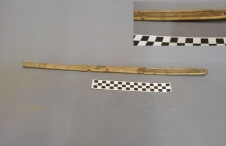Gypsum Cave
Gypsum Cave is a five-room limestone cave in Sunrise Mountain, approximately 12 miles east of Las Vegas. For a twelve-month period, between January 1930 and 1931, noted early archaeologist Mark R. Harrington (1882-1971) and a small crew of Native Americans dug through most of the cave's deposit. Harrington was interested in the cave for its potential to provide evidence of a period in the distant past when it was occupied by both humans and now-extinct mammals, especially the ground sloth (Nothrotheriops shastense). Gypsum Cave is significant because it yields artifacts related to early human occupation and information about the region's ancient ecosystem. It is also important to the early history of North American archaeology.
Harrington did not have the benefit of radiocarbon dating or the bank of regional information that now exists concerning the various kinds of prehistoric material he was unearthing. What he did have was a field approach that emphasized stratigraphic relationships and an analytical approach that was interdisciplinary. These approaches, which were cutting-edge compared to the work of many of his contemporaries, became standard practice with the rise of New Archaeology in the last quarter of the twentieth century.
Harrington's excavation yielded an extraordinary collection of terminal-Pleistocene paleontological and Holocene archaeological specimens. In different places within the cave, he found hand-carved wooden foreshafts from dart/atlatl weapons and dark lenses, which he interpreted as the remains of hearths, below a layer of sloth dung. Harrington presented the “many finds, scattered about the cave under widely varying conditions” as evidence that Pleistocene megafauna and Ice Age humans were contemporaneous. This evidence met with immediate skepticism from a number of his peers and generated much debate in the decades that followed. It also spurred research to recover comparable evidence elsewhere, such as at nearby Tule Springs.
The paleontological and artifact assemblages from Gypsum Cave were studied anew with the advent of radiocarbon dating. This method placed sloth dung from the cave from about 8,500 to 10,500 BP (before present, a scientific time scale). With improved techniques, subsequent radiocarbon dates have extended the presence of sloths in the cave deeper into the past, on the order of 20,000 to 33,000 years BP.
In contrast, most human artifacts are much younger. In the 1960s, researchers obtained radiocarbon dates of 2,400 years BP for sticks from one of the purported hearths and 2,900 years BP on a dart shaft fragment, both of which Harrington had allegedly recovered from beneath a layer of sloth dung. Recent radiocarbon dates on nine other cane and wooden dart fragments from a variety of rooms and stratigraphic contexts fall narrowly between about 3,300 and 4,250 years BP, establishing Harrington's “Gypsum Culture” assemblage as 3,000 to 4,500 years BP. The oldest implement now documented from the cave is a fragment of a 9,280-year-old basket found in a crevice in Room 3. It is among the oldest pieces of basketry ever found in North America, and its weave is unlike that of other basketry traditions documented in the region.
In 2004, D. Craig Young and Amy Gilreath re-inspected and reanalyzed a deep stratigraphic exposure in Room 1, reaching three conclusions. First, Harrington's sloth dung layer and the strata immediately above and below it were really one layer, lacked cultural material, and yielded radiocarbon dates of 11,060 to 11,490 years BP. This is roughly the period when the ground sloth became extinct. Second, a dark lens identified by Harrington as “Fireplace 2” appeared instead to be some type of residue from something such as mold or decomposition of sloth dung rather than charcoal in a fire-pit. Finally, the quantity and size of rock that comprised most of the deposit left large crevices and gaps. Secondary gypsum deposits have since formed, draped like a sheet through the rocky matrix and preventing these cavities from filling in. Packrats had scurried through this three-dimensional natural maze, dragging their treasures through the deposits. Neither Harrington nor his paleontologist, Chester Stock, had recognized this source of mixing, thinking instead that there were cultural materials both above and below the sloth layers, and thus falsely concluding that people and ground sloths occupied the cave at roughly the same time.
Gypsum Cave will, no doubt, continue to enlarge our understanding of the natural and cultural history of the American West in the years ahead and serves as an important site for continued scientific work. The cave is likewise a significant site to local Native American people, and it should be respected as such and not disturbed.
Article Locations
Related Articles
Further Reading
None at this time.


